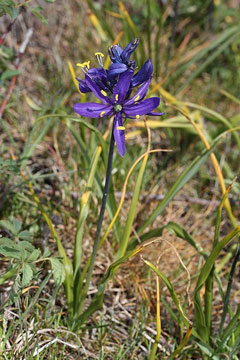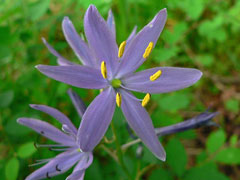 |
|
http://commons.wikimedia.org/wiki/User:Wsiegmund |
 |
| http://commons.wikimedia.org/wiki/User:Wsiegmund |
Translate this page:
Summary
Physical Characteristics

 Camassia quamash is a BULB growing to 0.3 m (1ft) by 0.2 m (0ft 8in).
Camassia quamash is a BULB growing to 0.3 m (1ft) by 0.2 m (0ft 8in).
See above for USDA hardiness. It is hardy to UK zone 3 and is not frost tender. It is in flower from May to June, and the seeds ripen from July to August. The species is hermaphrodite (has both male and female organs) and is pollinated by Bees.
It is noted for attracting wildlife.
Suitable for: light (sandy), medium (loamy) and heavy (clay) soils and can grow in heavy clay soil. Suitable pH: mildly acid, neutral and basic (mildly alkaline) soils. It can grow in semi-shade (light woodland) or no shade. It prefers moist soil.
UK Hardiness Map
US Hardiness Map
Synonyms
C. esculenta. Lindl.
Plant Habitats
Lawn; Meadow; Cultivated Beds;
Edible Uses
Edible Parts: Root
Edible Uses:
Bulb - raw or cooked[62, 95]. The bulb, which can be up to 5cm in diameter[270], has a mild, starchy flavour when eaten raw, but a gummy texture that reduces the enjoyment of it somewhat[K]. When cooked, however, it develops a delicious sweet flavour somewhat like sweet chestnuts[92], and is a highly nutritious food[2]. Excellent when slow baked, it can also be dried and made into a powder which can be used as a thickener in stews or mixed with cereal flours when making bread, cakes etc[K]. The bulbs can be boiled down to make a molasses, this was used on festival occasions by various Indian tribes[2, 183]. The bulbs can be harvested at any time of the year[85], but are probably best in early summer when the seeds are ripe[94]. One report says that the bulbs contain inulin (a starch that cannot be digested by humans) but that this breaks down when the bulb is cooked slowly to form the sugar fructose which is sweet and easily digested[256]. Quamash bulbs were a staple food of the N. American Indians[42, 92]. The tribes would move to the Quamash fields in the early autumn and, whilst some people harvested the bulbs, others would dig a pit, line it with boulders then fill it with wood and set fire to it. The fire would heat the boulders and the harvested bulbs would then be placed in the pit and the whole thing covered with earth and the bulbs left to cook slowly for 2 days. The pit would then be opened and the Indians would feast on the bulbs until they could no longer fit any more in their stomachs. Whatever was left would be dried and stored for winter use.
References More on Edible Uses
Medicinal Uses
Plants For A Future can not take any responsibility for any adverse effects from the use of plants. Always seek advice from a professional before using a plant medicinally.
Birthing aid Oxytoxic
A decoction of the roots has been used to induce labour[257]. An infusion of the leaves has been used to treat vaginal bleeding after birth and to help expel the placenta[257].
References More on Medicinal Uses
The Bookshop: Edible Plant Books
Our Latest books on Perennial Plants For Food Forests and Permaculture Gardens in paperback or digital formats.

Edible Tropical Plants
Food Forest Plants for Hotter Conditions: 250+ Plants For Tropical Food Forests & Permaculture Gardens.
More

Edible Temperate Plants
Plants for Your Food Forest: 500 Plants for Temperate Food Forests & Permaculture Gardens.
More

More Books
PFAF have eight books available in paperback and digital formats. Browse the shop for more information.
Shop Now
Other Uses
Notable Products: Nectar, pollen, edible bulb. Attracts Wildlife - flowers attract beneficial insects. Grown as an ornamental plant.
Special Uses
Attracts Wildlife Food Forest
References More on Other Uses
Cultivation details
Succeeds in almost any soil[42]. Grows well in heavy clay soils. Prefers a rather heavy loam[1] that has plenty of moisture in spring but does not remain wet over the winter[138, 200]. Dislikes dry soils[200]. Prefers full sun but tolerates partial shade[138, 200]. The dormant bulbs are very hardy and will withstand soil temperatures down to at least -10°c[214]. Quamash is a very pretty flowering bulb that has quite a large potential as an edible ornamental plant[K]. It grows very well in the flower border but can also be naturalised in damp grass[134]. We are intending to grow it in a grassed-down orchard in our Cornish trial ground. The bulbs flower in late spring and early summer and have completely died down by early July so they do not interfere with harvesting the apple crop. The grass in the orchard will be cut in early spring before the quamash comes into growth, but will not be cut again until July. The bulbs will be harvested at any time from July to December and, since it is impossible to find all the bulbs, it is hoped that those remaining will be able to increase and supply bulbs for future years[K]. A polymorphic and very ornamental plant[1], there are some named varieties[200]. The subspecies C. quamash maxima has larger bulbs than the type, up to 65mm in diameter[270]. A good bee plant[108]. This species can be confused with certain poisonous bulbs in the genus Zigadenus[85]. Plant the bulbs 7 - 10cm deep in early autumn and then leave undisturbed[1]. The plant is heat tolerant in zones 12 through 1. (Plant Hardiness Zones show how well plants withstand cold winter temperatures.
Plant Heat Zones show when plants would start suffering from the heat.
The Plant Heat Zone map is based on the number of "heat days" experienced in a given area where the temperature climbs to over 86 degrees F (30°C).
At this temperature, many plants begin to suffer physiological damage. Heat Zones range from 1 (no heat days) to 12 (210 or more heat days).
For example Heat Zone. 11-1 indicates that the plant is heat tolerant in zones 11 through 1.) For polyculture design as well as the above-ground architecture (form - tree, shrub etc. and size shown above) information on the habit and root pattern is also useful and given here if available. The plant growth habit is a runner spreading indefinitely by rhizomes or stolons [1-2]. Ephemeral emerging in spring and dying back by summer every year [1-2]. The root pattern is a bulb.
References Carbon Farming Information and Carbon Sequestration Information
Temperature Converter
Type a value in the Celsius field to convert the value to Fahrenheit:
Fahrenheit:
The PFAF Bookshop
Plants For A Future have a number of books available in paperback and digital form. Book titles include Edible Plants, Edible Perennials, Edible Trees,Edible Shrubs, Woodland Gardening, and Temperate Food Forest Plants. Our new book is Food Forest Plants For Hotter Conditions (Tropical and Sub-Tropical).
Shop Now
Plant Propagation
Seed - best sown as soon as it is ripe in a cold frame[134]. The seed can also be sown in a cold frame in spring[134]. It usually germinates in 1 - 6 months at 15°c, but it can be erratic[138]. Sow the seed thinly so that it does not need to be thinned and allow the seedlings to grow on undisturbed for their first year. Give an occasional liquid feed to ensure that the plants do not become nutrient deficient. When the plants are dormant in late summer, pot up the small bulbs putting 2 - 3 bulbs in each pot. Grow them on for another one or two years in a cold frame before planting them out when dormant in late summer. Offsets in late summer. The bulb has to be scored in order to produce offsets.
Other Names
If available other names are mentioned here
Wild Hyacinth, Camas, small Camas, common Camash or Quamash.
Native Range
NORTHERN AMERICA: Canada, Alberta (south), British Columbia (south), United States, Idaho, Montana (west), Oregon, Washington, Wyoming (west), California (north), Nevada (northwest), Utah (north),
Weed Potential
Right plant wrong place. We are currently updating this section.
Please note that a plant may be invasive in one area but may not in your area so it's worth checking.
Conservation Status
IUCN Red List of Threatened Plants Status :

Growth: S = slow M = medium F = fast. Soil: L = light (sandy) M = medium H = heavy (clay). pH: A = acid N = neutral B = basic (alkaline). Shade: F = full shade S = semi-shade N = no shade. Moisture: D = dry M = Moist We = wet Wa = water.
Now available:
Food Forest Plants for Mediterranean Conditions
350+ Perennial Plants For Mediterranean and Drier Food Forests and Permaculture Gardens.
[Paperback and eBook]
This is the third in Plants For A Future's series of plant guides for food forests tailored to
specific climate zones. Following volumes on temperate and tropical ecosystems, this book focuses
on species suited to Mediterranean conditions—regions with hot, dry summers and cool, wet winters,
often facing the added challenge of climate change.
Read More
Expert comment
Author
(Pursh.)Greene.
Botanical References
60200270
Links / References
For a list of references used on this page please go here
Readers comment